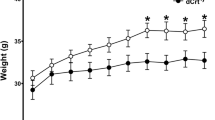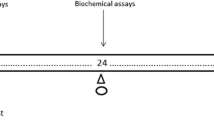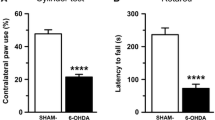Abstract
We have tested whether the lack of chromogranins (Cgs) A and B could provoke CNS disorders when combined with an excess of dopamine. We chronically treated (over 6 months) mice lacking both chromogranins A and B (Cgs-KO) with a low oral dosage of L-DOPA/benserazide (10/2.5 mg/kg). Motor performance in the rota-rod test, open field activity, and metabolic cages indicated a progressive impairment in motor coordination in these mice, and an increase in rearing behavior, which was accompanied by an increase in DA within the substantia nigra. We conclude that mild chronic L-DOPA treatment does not produce nigro-striatal toxicity that could be associated with parkinsonism, neither in control nor Cgs-KO mice. Rather, Cgs-KO mice exhibit behaviors compatible with an amphetamine-like effect, probably caused by the excess of catecholamines in the CNS.




Similar content being viewed by others

References
Bailey RC, Jackson DM, Bracs PU (1979) Long-term L-dopa pretreatment of mice: central receptor subsensitivity or supersensitivity? Psychopharmacology 66:55–61
Bandyopadhyay GK, Mahata SK (2017) Chromogranin a regulation of obesity and peripheral insulin sensitivity. Front Endocrinol (Lausanne) 8:20
Bartolomucci A, Possenti R, Mahata SK, Fischer-Colbrie R, Loh YP, Salton SR (2011) The extended granin family: structure, function, and biomedical implications. Endocr Rev 32:755–797
Blaschko H, Comline RS, Schneider FH, Silver M, Smith AD (1967) Secretion of a chromaffin granule protein, chromogranin, from the adrenal gland after splanchnic stimulation. Nature 215:58–59
Blesa J, Pifl C, Sanchez-Gonzalez MA, Juri C, Garcia-Cabezas MA, Adanez R, Iglesias E, Collantes M, Penuelas I, Sanchez-Hernandez JJ, Rodriguez-Oroz MC, Avendano C, Hornykiewicz O, Cavada C, Obeso JA (2012) The nigrostriatal system in the presymptomatic and symptomatic stages in the MPTP monkey model: a PET, histological and biochemical study. Neurobiol Dis 48:79–91
Borges R, Sala F, Garcia AG (1986) Continuous monitoring of catecholamine release from perfused cat adrenals. J Neurosci Methods 16:289–300
Borges R, Diaz-Vera J, Dominguez N, Arnau MR, Machado JD (2010) Chromogranins as regulators of exocytosis. J Neurochem 114:335–343
Brooks DJ (2010) Imaging approaches to Parkinson disease. J Nucl Med 51:596–609
Burke WJ, Kumar VB, Pandey N, Panneton WM, Gan Q, Franko MW, O'Dell M, Li SW, Pan Y, Chung HD, Galvin JE (2008) Aggregation of alpha-synuclein by DOPAL, the monoamine oxidase metabolite of dopamine. Acta Neuropathol 115:193–203
Cannon JR, Tapias V, Na HM, Honick AS, Drolet RE, Greenamyre JT (2009) A highly reproducible rotenone model of Parkinson’s disease. Neurobiol Dis 34:279–290
Castaneyra-Ruiz L, Gonzalez-Marrero I, Hernandez-Abad LG, Carmona-Calero EM, Meyer G, Castaneyra-Perdomo A (2016) A distal to proximal gradient of human choroid plexus development, with antagonistic expression of Glut1 and AQP1 in mature cells vs. calbindin and PCNA in proliferative cells. Front Neuroanat 10:87
Diaz-Vera J, Morales YG, Hernandez-Fernaud JR, Camacho M, Montesinos MS, Calegari F, Huttner WB, Borges R, Machado JD (2010) Chromogranin B gene ablation reduces the catecholamine cargo and decelerates exocytosis in chromaffin secretory vesicles. J Neurosci 30:950–957
Diaz-Vera J, Camacho M, Machado JD, Dominguez N, Montesinos MS, Hernandez-Fernaud JR, Lujan R, Borges R (2012) Chromogranins A and B are key proteins in amine accumulation, but the catecholamine secretory pathway is conserved without them. FASEB J 26:430–438
Dominguez N, Estevez-Herrera J, Borges R, Machado JD (2014) The interaction between chromogranin A and catecholamines governs exocytosis. FASEB J 28:4657–4667
Fornai F, Battaglia G, Gesi M, Giorgi FS, Orzi F, Nicoletti F, Ruggieri S (2000) Time-course and dose-response study on the effects of chronic L-DOPA administration on striatal dopamine levels and dopamine transporter following MPTP toxicity. Brain Res 887:110–117
Goldstein DS, Sullivan P, Holmes C, Miller GW, Alter S, Strong R, Mash DC, Kopin IJ, Sharabi Y (2013) Determinants of buildup of the toxic dopamine metabolite DOPAL in Parkinson’s disease. J Neurochem 126:591–603
Goldstein DS, Kopin IJ, Sharabi Y (2014) Catecholamine autotoxicity. Implications for pharmacology and therapeutics of Parkinson disease and related disorders. Pharmacol Ther
Helle KB, Metz-Boutigue MH, Cerra MC, Angelone T (2018) Chromogranins: from discovery to current times. Pflugers Arch 470:143–154
Jenner P, Olanow CW (1996) Oxidative stress and the pathogenesis of Parkinson’s disease. Neurology 47:S161–S170
Kim T, Tao-Cheng JH, Eiden LE, Loh YP (2001) Chromogranin A, an "on/off" switch controlling dense-core secretory granule biogenesis. Cell 106:499–509
Lever C, Burton S, O'Keefe J (2006) Rearing on hind legs, environmental novelty, and the hippocampal formation. Rev Neurosci 17:111–133
Mahapatra NR, O'Connor DT, Vaingankar SM, Hikim AP, Mahata M, Ray S, Staite E, Wu H, Gu Y, Dalton N, Kennedy BP, Ziegler MG, Ross J, Mahata SK (2005) Hypertension from targeted ablation of chromogranin A can be rescued by the human ortholog. J Clin Invest 115:1942–1952
Mena MA, Davila V, Sulzer D (1997) Neurotrophic effects of L-DOPA in postnatal midbrain dopamine neuron/cortical astrocyte cocultures. J Neurochem 69:1398–1408
Montesinos MS, Machado JD, Camacho M, Diaz J, Morales YG, Alvarez de la Rosa D, Carmona E, Castaneyra A, Viveros OH, O'Connor DT, Mahata SK, Borges R (2008) The crucial role of chromogranins in storage and exocytosis revealed using chromaffin cells from chromogranin A null mouse. J Neurosci 28:3350–3358
Nikolaus S, Beu M, De Souza Silva AM, Huston JP, Hautzel H, Chao OY, Antke C, Muller HW (2014) Relationship between L-DOPA-induced reduction in motor and exploratory activity and degree of DAT binding in the rat. Front Behav Neurosci 8:431
Obermuller S, Calegari F, King A, Lindqvist A, Lundquist I, Salehi A, Francolini M, Rosa P, Rorsman P, Huttner WB, Barg S (2010) Defective secretion of islet hormones in chromogranin-B deficient mice. PLoS One 5:e8936
Pereda D, Pardo MR, Morales YG, Dominguez N, Arnau MR, Borges R (2015) Mice lacking chromogranins exhibit increased aggressive and depression-like behaviour. Behav Brain Res 278:98–106
Poewe WH, Lees AJ, Stern GM (1986) Low-dose L-dopa therapy in Parkinson’s disease: a 6-year follow-up study. Neurology 36:1528–1530
Spencer JP, Jenner A, Butler J, Aruoma OI, Dexter DT, Jenner P, Halliwell B (1996) Evaluation of the pro-oxidant and antioxidant actions of L-DOPA and dopamine in vitro: implications for Parkinson’s disease. Free Radic Res 24:95–105
Taupenot L, Harper KL, Mahapatra NR, Parmer RJ, Mahata SK, O'Connor DT (2002) Identification of a novel sorting determinant for the regulated pathway in the secretory protein chromogranin A. J Cell Sci 115:4827–4841
Taupenot L, Harper KL, O'Connor DT (2003) The chromogranin-secretogranin family. N Engl J Med 348:1134–1149
Taylor TN, Alter SP, Wang M, Goldstein DS, Miller GW (2014) Reduced vesicular storage of catecholamines causes progressive degeneration in the locus ceruleus. Neuropharmacology 76(Pt A):97–105
Acknowledgments
We thank Ms. Lidia Ruiz for her excellent work in processing the tissue for microscopy, and our discussions with Dr. Daniel Marcellino (Department of Integrative Medical Biology, Umeå, Sweden) were greatly appreciated.
Funding
This work was supported by the Spanish Ministerio de Ciencia, Innovación y Universidades (BFU2017-82618-P). LCR received a PhD fellowship from Fundación CajaCanarias (Spain).
Author information
Authors and Affiliations
Corresponding author
Ethics declarations
Ethical approval
All procedures involving animals were performed in accordance with institutional (Universidad de La Laguna, CEIBA-2014-0125a) and national guidelines, and in compliance with the EU guidelines in directive EC/63/2010.
Conflict of interest
The authors declare that they have no conflict of interest.
Informed consent
This is not applicable.
Additional information
Publisher’s note
Springer Nature remains neutral with regard to jurisdictional claims in published maps and institutional affiliations.
Rights and permissions
About this article
Cite this article
Castañeyra-Ruiz, L., Castañeyra, A., González-Santana, A. et al. Combining the lack of chromogranins with chronic L-DOPA treatment affects motor activity in mice. Cell Tissue Res 380, 59–66 (2020). https://doi.org/10.1007/s00441-019-03159-8
Received:
Accepted:
Published:
Issue Date:
DOI: https://doi.org/10.1007/s00441-019-03159-8



